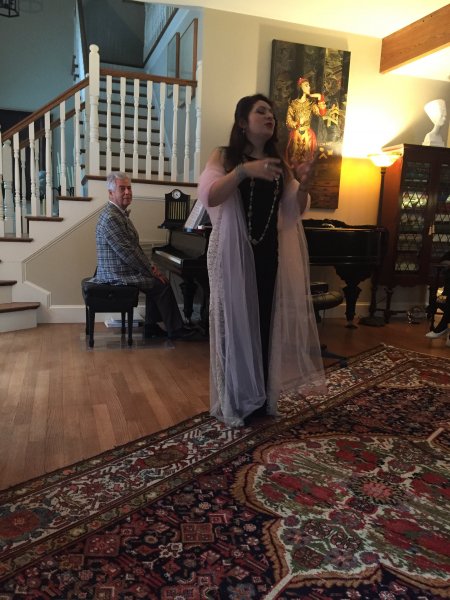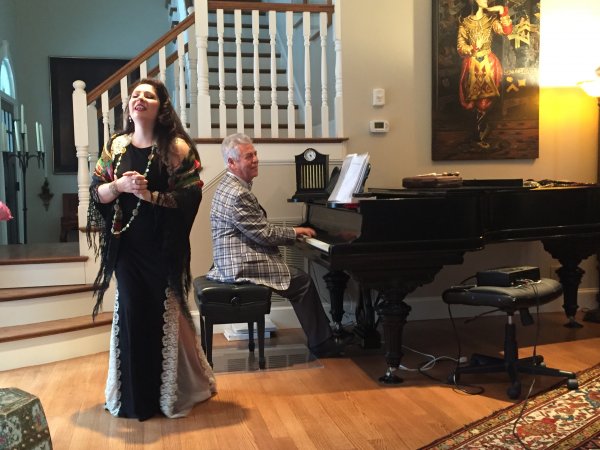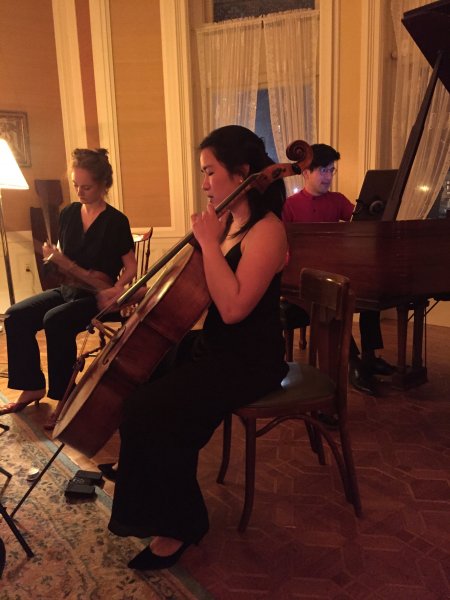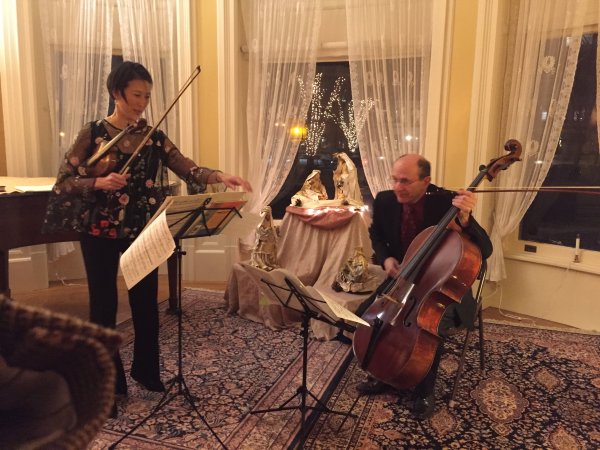Is Live, Unamplified Music the Correct Reference for the Sound of our Audio Systems?
- Thread starter Ron Resnick
- Start date
You are using an out of date browser. It may not display this or other websites correctly.
You should upgrade or use an alternative browser.
You should upgrade or use an alternative browser.
I had the distinct pleasure of hearing Ukranian soprano Olga Lisovskya yesterday in a friend’s living room accompanied by a Russian pianist named Boris. Al M. joined me. She sang arias and lieder from Shubert, Puccini, Verdi and more. I was struck by just how powerful and controlled her voice was. Incredible energy, so close and personal in a domestic setting. And she did a great job of acting and keeping it interesting. Very dramatic and emotional stuff and another live experience for the memory banks.
I wish my system could approach this level of power, clarity, dynamics and sheer energy. It was a reality check and perhaps an excellent guide as I continue my experiments with cartridge loading and what sounds most natural.
Experiences like these make me want to forget our debates about analog and digital. It is about the joy of music and the quality of the performance that drives this passion.


I wish my system could approach this level of power, clarity, dynamics and sheer energy. It was a reality check and perhaps an excellent guide as I continue my experiments with cartridge loading and what sounds most natural.
Experiences like these make me want to forget our debates about analog and digital. It is about the joy of music and the quality of the performance that drives this passion.


I am glad you had a great time!
So what do you (most or all of us) need to add to (or eliminate from) our systems to approach the level of energy you heard?
So what do you (most or all of us) need to add to (or eliminate from) our systems to approach the level of energy you heard?
More live musicians, indeed. Failing that, big honking horns or maybe well-designed transmission line speakers would be the closest I've heard to the dynamics and energy of the real thing. Not an option for me though, as either one would over-power my room.
More live musicians, indeed. Failing that, big honking horns or maybe well-designed transmission line speakers would be the closest I've heard to the dynamics and energy of the real thing. Not an option for me though, as either one would over-power my room.
Yes, more live musicians. Also, most vocal experiences and recordings are not in such settings. Usually the audience sits further away, or it's recorded from the perspective of a stage rather than a living room (especially applicable to the operatic material yesterday, perhaps less so the Lieder). In that case the dynamic jump factor, which was really extraordinary yesterday, diminishes quickly. Thus, on the usual vocal recordings also a horn speaker will not change much.
I am glad you had a great time!
So what do you (most or all of us) need to add to (or eliminate from) our systems to approach the level of energy you heard?
Hi Ron, I really don't have the technical background to answer such a question. I suppose one could start with trying to reduce distortion and increase things like dynamics and that sense of effortlessness. More specifically, we could strive for a more "natural" sound from our systems, and one that avoids "hifi". Of course, that is easier said than done.
I harped a bit too hard on a friend by repeatedly asking him to describe the very slight differences he heard when comparing the same excellent recording on two different sources in his system. He finally responded by saying "You will have to hear for yourself; timbre is just hard to describe." I think this pretty well sums it up. We have to use our own experiences to make judgements, our ears to assess progress with our systems, and the advice of those who have more technical knowledge to help guide us toward gear that best addresses some of these audio challenges.
It is worth noting that my host is a baritone who still sings and occasionally records. He is also a music lover. I visited him a few years ago and we met in his "music room". It was a large, cool, stone-walled space surrounded by shelving filled with records, mostly opera. In the center of the room sat a round table, a few candles, a picture frame, and a couple of chairs. We drank some wine and listened to his two modest speakers from his old turntable and receiver. The speakers were outside in the hallway leading to the room. We could easily have been in a dimly lit wine cellar tasting Burgundy or Chablis.
I later invited him to hear my system and suggested he bring some music. He brought some Fischer-Dieskau among others rare, original pressings. I asked him what he thought. His responses were all about the performances, the singers' emotions, the various interpretations of the music. They had nothing whatsoever to do with the quality of the reproduction or sonic attributes. He could not have cared less about any of that.
I like to think that he could more deeply appreciate the qualities of those performances through my fairly good system, but I will never know, because I could not bring myself to ask him. In the end, we devote a lot of time and effort to assemble what we think of as satisfying high end audio systems. In reality, they are just music delivery devices. The music, and the thoughts and emotions that it conjures, is what matters to my friend.
That lesson and experiences like the one Al M. and I enjoyed yesterday in this friend's living room, are the reasons I enjoy my friendship with the host.
Yes, more live musicians. Also, most vocal experiences and recordings are not in such settings. Usually the audience sits further away, or it's recorded from the perspective of a stage rather than a living room (especially applicable to the operatic material yesterday, perhaps less so the Lieder). In that case the dynamic jump factor, which was really extraordinary yesterday, diminishes quickly. Thus, on the usual vocal recordings also a horn speaker will not change much.
At California Audio Show, the Triangle Art room featured all Triangle Art gear including the big boy turntable, in to the too of the line Angel City Audio transmission line speakers. It was a large room. I'd guess 30'x15' or so. I sat center stage next to a guy who was feeding in various Jazz remasters that I was very familiar with. He asked me to pick the first record, and I chose Jimmy Forrest's Out Of The Forrest. The instant the sax cut in, I was blown away. It cut through me like a knife, in a realistic, life like, holy cow way. Here was a record I grew up with, sounding barely recognizable - but in a good way, a jaw dropping way. I was so amazed I called the ACA guy the next week, as he wasn't at the show when I was, and told him "wow!". He said that room wasn't even large enough for his speakers. Mind you, they are not huge, either. I want to say 9" drivers or so? But wow, what a sound. It was discombobulating at first. I almost had to ask if he played the right record. So, I do think that up close live dynamic sound is out there... It's just very elusive, and people like me don't have the space to attempt achieving it.
At California Audio Show, the Triangle Art room featured all Triangle Art gear including the big boy turntable, in to the too of the line Angel City Audio transmission line speakers. It was a large room. I'd guess 30'x15' or so. I sat center stage next to a guy who was feeding in various Jazz remasters that I was very familiar with. He asked me to pick the first record, and I chose Jimmy Forrest's Out Of The Forrest. The instant the sax cut in, I was blown away. It cut through me like a knife, in a realistic, life like, holy cow way. Here was a record I grew up with, sounding barely recognizable - but in a good way, a jaw dropping way. I was so amazed I called the ACA guy the next week, as he wasn't at the show when I was, and told him "wow!". He said that room wasn't even large enough for his speakers. Mind you, they are not huge, either. I want to say 9" drivers or so? But wow, what a sound. It was discombobulating at first. I almost had to ask if he played the right record. So, I do think that up close live dynamic sound is out there... It's just very elusive, and people like me don't have the space to attempt achieving it.
Sure, but i was specifically talking about a vocal performance, such as yesterday.
Sure, but i was specifically talking about a vocal performance, such as yesterday.
You'll get the same sort of effect from vocal performances in this system. Especially belting. You will feel it.
Both,
Because a grand piano will test the system and so Will amplified music, such as “Dark Side of The Moon.
I want a Bosendorfer low end to sound like Oscar Peterson’s Bosendorfer. I also like DSOTM to be clear and focused without congestion and stridency.
Because a grand piano will test the system and so Will amplified music, such as “Dark Side of The Moon.
I want a Bosendorfer low end to sound like Oscar Peterson’s Bosendorfer. I also like DSOTM to be clear and focused without congestion and stridency.
You'll get the same sort of effect from vocal performances in this system. Especially belting. You will feel it.
I made a different point. Most vocal recordings aren't that way, especially opera recordings when it's about 'belting'. If it's not from that much of a close-up perspective, you won't get that jump factor, regardless of how dynamic the system is. You won't get that jump factor live from a bit of a distance either.
Forgive me if this has been discussed elsewhere in the thread, I've been following but there are a lot of entries...
In our little audiophile club here in Portland, we occasionally have someone perform live. I think, like Peter posted above listening to the singer, the "energy" is probably the thing most noticeably different live vs. recorded/reproduced. When one of our guests played his cello, I was struck by the energy and volume of the cello, even when played quietly/tenderly. I don't know the language of classical music (fortissimo, adigio, etc) but when he played the cello with great gusto the volume of the instrument was quite stunning, as was the visceral impact. Live, unamplified acoustic music has real energy, unless the performers are purposely playing very softly. It is difficult to reproduce visceral impact with our systems without playing at "realistic" volume.
In our little audiophile club here in Portland, we occasionally have someone perform live. I think, like Peter posted above listening to the singer, the "energy" is probably the thing most noticeably different live vs. recorded/reproduced. When one of our guests played his cello, I was struck by the energy and volume of the cello, even when played quietly/tenderly. I don't know the language of classical music (fortissimo, adigio, etc) but when he played the cello with great gusto the volume of the instrument was quite stunning, as was the visceral impact. Live, unamplified acoustic music has real energy, unless the performers are purposely playing very softly. It is difficult to reproduce visceral impact with our systems without playing at "realistic" volume.
I think, like Peter posted above listening to the singer, the "energy" is probably the thing most noticeably different live vs. recorded/reproduced. When one of our guests played his cello, I was struck by the energy and volume of the cello, even when played quietly/tenderly. I don't know the language of classical music (fortissimo, adigio, etc) but when he played the cello with great gusto the volume of the instrument was quite stunning, as was the visceral impact. Live, unamplified acoustic music has real energy, unless the performers are purposely playing very softly. It is difficult to reproduce visceral impact with our systems without playing at "realistic" volume.
Bob, I could not agree more. I have listened to strings sitting right in front of the musicians.
After years of thinking about audio's sonic attributes like dynamics, resolution and soundstaging, I am shifting my focus and attention more towards two more general observations: energy and natural sound. These are the characteristics which I increasingly notice when I attend small and large scale performances, sitting up close to the musicians. Understanding the incredible sense of energy and learning to recognize natural sound helps guide me during my current experiments with cartridge loading, speaker positioning, signal cables, and power cords.
Here are photos of two more concerts I recently attended. These too were small ensembles also in a living room setting in Boston.


Peter, I think we have to recognise that we audiophiles are a self-selecting group who beat ourselves up over terms like transparency, delicacy etc.
I treat some professional opera singers, one of which I've seen in concert and has heard my system, and the systems of others.
She kinda hears the music in her head, imagines it as the composer imagined. Her take on the acoustics of the concert hall, and in a listening room is v different from us.
When I asked what she felt when I played some opera to her, she didn't reply w our checklist. She just connected big time w the music, saying communication of emotion was high, and refused to delve further. She loved my sound. But she also loves music on ear buds LOL.
I treat some professional opera singers, one of which I've seen in concert and has heard my system, and the systems of others.
She kinda hears the music in her head, imagines it as the composer imagined. Her take on the acoustics of the concert hall, and in a listening room is v different from us.
When I asked what she felt when I played some opera to her, she didn't reply w our checklist. She just connected big time w the music, saying communication of emotion was high, and refused to delve further. She loved my sound. But she also loves music on ear buds LOL.
Great experiences and observations thanks Peter.Bob, I could not agree more. I have listened to strings sitting right in front of the musicians.
After years of thinking about audio's sonic attributes like dynamics, resolution and soundstaging, I am shifting my focus and attention more towards two more general observations: energy and natural sound. These are the characteristics which I increasingly notice when I attend small and large scale performances, sitting up close to the musicians. Understanding the incredible sense of energy and learning to recognize natural sound helps guide me during my current experiments with cartridge loading, speaker positioning, signal cables, and power cords.
Here are photos of two more concerts I recently attended. These too were small ensembles also in a living room setting in Boston.
View attachment 48909
View attachment 48910
The longer I go the more I find I am less focused on just sonic criteria and more purely in the holistic engagement in the music.
So music is the aim and also the assessment and I have recently ended up with horns and Harbeths and SET as my happy and emotionally engaging place. It also happens that both these speakers when driven with SET also render instruments essentially naturally if not exactly tho exactly isn’t needed when you let yourself be in the music rather than focussed on the sound.
Also loving the fact that you guys still reinforce the importance in live experiences as well as recorded. These private concerts look amazingly like they recall exactly where music all started... in great moments of intimacy and sharing.
HornsI am glad you had a great time!
So what do you (most or all of us) need to add to (or eliminate from) our systems to approach the level of energy you heard?
Horns
No prizes for answering the easiest question asked on the forum
Similar threads
- Replies
- 4
- Views
- 882
- Replies
- 20
- Views
- 698
- Sticky
- Replies
- 57
- Views
- 16K
- Replies
- 7
- Views
- 1K
| Steve Williams Site Founder | Site Owner | Administrator | Ron Resnick Site Owner | Administrator | Julian (The Fixer) Website Build | Marketing Managersing |






